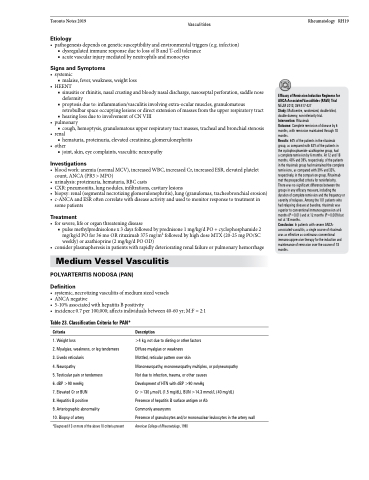Page 1305 - TNFlipTest
P. 1305
Toronto Notes 2019 Vasculitides
Etiology
• pathogenesisdependsongeneticsusceptibilityandenvironmentaltriggers(e.g.infection) ■ dysregulated immune response due to loss of B and T-cell tolerance
■ acute vascular injury mediated by neutrophils and monocytes
Signs and Symptoms
• systemic
■ malaise, fever, weakness, weight loss
• HEENT
■ sinusitis or rhinitis, nasal crusting and bloody nasal discharge, nasoseptal perforation, saddle nose
deformity
■ proptosis due to: inflammation/vasculitis involving extra-ocular muscles, granulomatous
retrobulbar space occupying lesions or direct extension of masses from the upper respiratory tract ■ hearing loss due to involvement of CN VIII
• pulmonary
■ cough, hemoptysis, granulomatous upper respiratory tract masses, tracheal and bronchial stenosis
• renal
■ hematuria, proteinuria, elevated creatinine, glomerulonephritis
• other
■ joint, skin, eye complaints, vasculitic neuropathy
Investigations
• bloodwork:anemia(normalMCV),increasedWBC,increasedCr,increasedESR,elevatedplatelet count, ANCA (PR3 > MPO)
• urinalysis:proteinuria,hematuria,RBCcasts
• CXR:pneumonitis,lungnodules,infiltrations,cavitarylesions
• biopsy:renal(segmentalnecrotizingglomerulonephritis),lung(granulomas,tracheobronchialerosion)
• c-ANCA and ESR often correlate with disease activity and used to monitor response to treatment in
some patients
Treatment
• forsevere,lifeororganthreateningdisease
■ pulse methylprednisolone x 3 days followed by prednisone 1 mg/kg/d PO + cyclophosphamide 2
mg/kg/d PO for 36 mo OR rituximab 375 mg/m2 followed by high dose MTX (20-25 mg PO/SC
weekly) or azathioprine (2 mg/kg/d PO OD)
• considerplasmapheresisinpatientswithrapidlydeterioratingrenalfailureorpulmonaryhemorrhage
Medium Vessel Vasculitis
POLYARTERITIS NODOSA (PAN)
Definition
• systemic,necrotizingvasculitisofmediumsizedvessels
• ANCAnegative
• 5-10%associatedwithhepatitisBpositivity
• incidence0.7per100,000;affectsindividualsbetween40-60yr;M:F=2:1
Rheumatology RH19
Efficacy of Remission Induction Regimens for ANCA-Associated Vasculitides (RAVE) Trial NEJM 2013; 369:417-427
Study: Multicentre, randomized, double-blind, double-dummy, non-inferiority trial. Intervention: Rituximab
Outcome: Complete remission of disease by 6 months, with remission maintained through 18 months.
Results: 64% of the patients in the rituximab
group, as compared with 53% of the patients in
the cyclophosphamide–azathioprine group, had
a complete remission by 6 months. At 12 and 18 months, 48% and 39%, respectively, of the patients in the rituximab group had maintained the complete remissions, as compared with 39% and 33%, respectively, in the comparison group. Rituximab met the prespecified criteria for noninferiority.
There was no significant difference between the groups in any efficacy measure, including the duration of complete remission and the frequency or severity of relapses. Among the 101 patients who had relapsing disease at baseline, rituximab was superior to conventional immunosuppression at 6 months (P=0.01) and at 12 months (P=0.009) but not at 18 months.
Conclusion: In patients with severe ANCA- associated vasculitis, a single course of rituximab was as effective as continuous conventional immunosuppressive therapy for the induction and maintenance of remission over the course of 18 months.
Table 23. Classification Criteria for PAN*
Criteria
1. Weight loss
2. Myalgias, weakness, or leg tenderness
3. Livedo reticularis
4. Neuropathy
5. Testicular pain or tenderness
6. dBP >90 mmHg
7. Elevated Cr or BUN
8. Hepatitis B positive
9. Arteriographic abnormality
10. Biopsy of artery
*Diagnosed if 3 or more of the above 10 criteria present
Description
>4 kg, not due to dieting or other factors
Diffuse myalgias or weakness
Mottled, reticular pattern over skin
Mononeuropathy, mononeuropathy multiplex, or polyneuropathy Not due to infection, trauma, or other causes
Development of HTN with dBP >90 mmHg
Cr >130 μmol/L (1.5 mg/dL), BUN >14.3 mmol/L (40 mg/dL)
Presence of hepatitis B surface antigen or Ab
Commonly aneurysms
Presence of granulocytes and/or mononuclear leukocytes in the artery wall American College of Rheumatology, 1990


